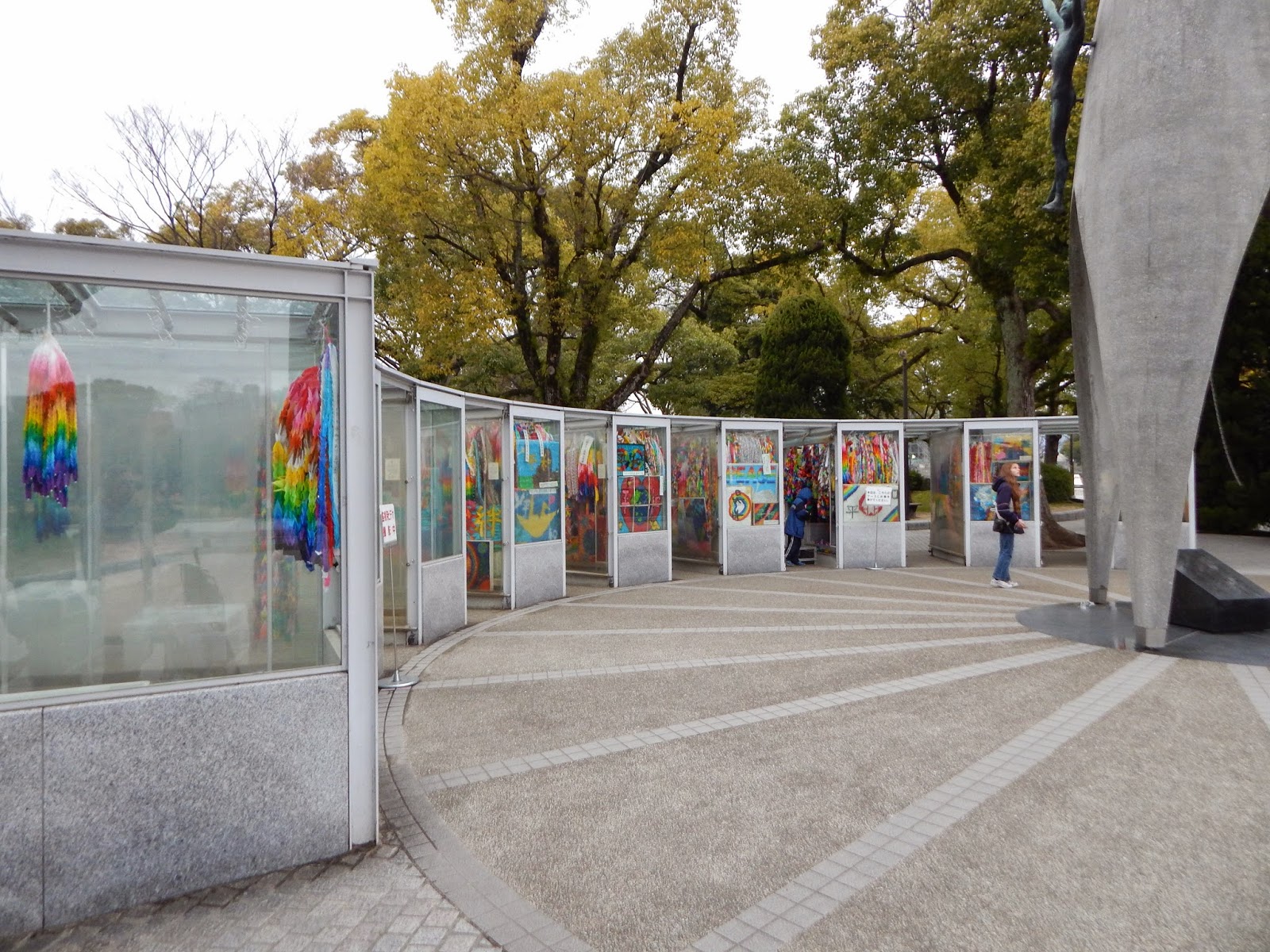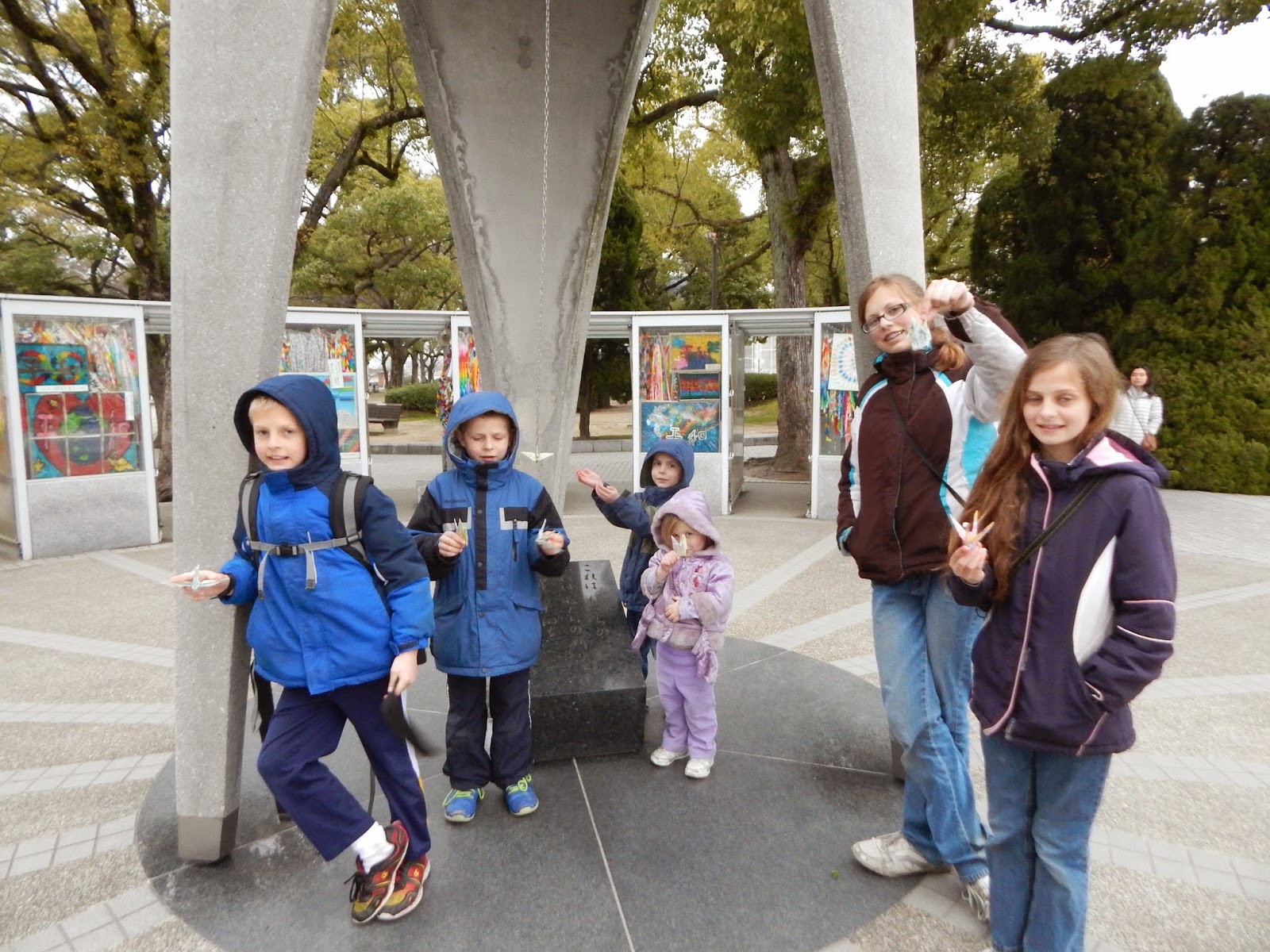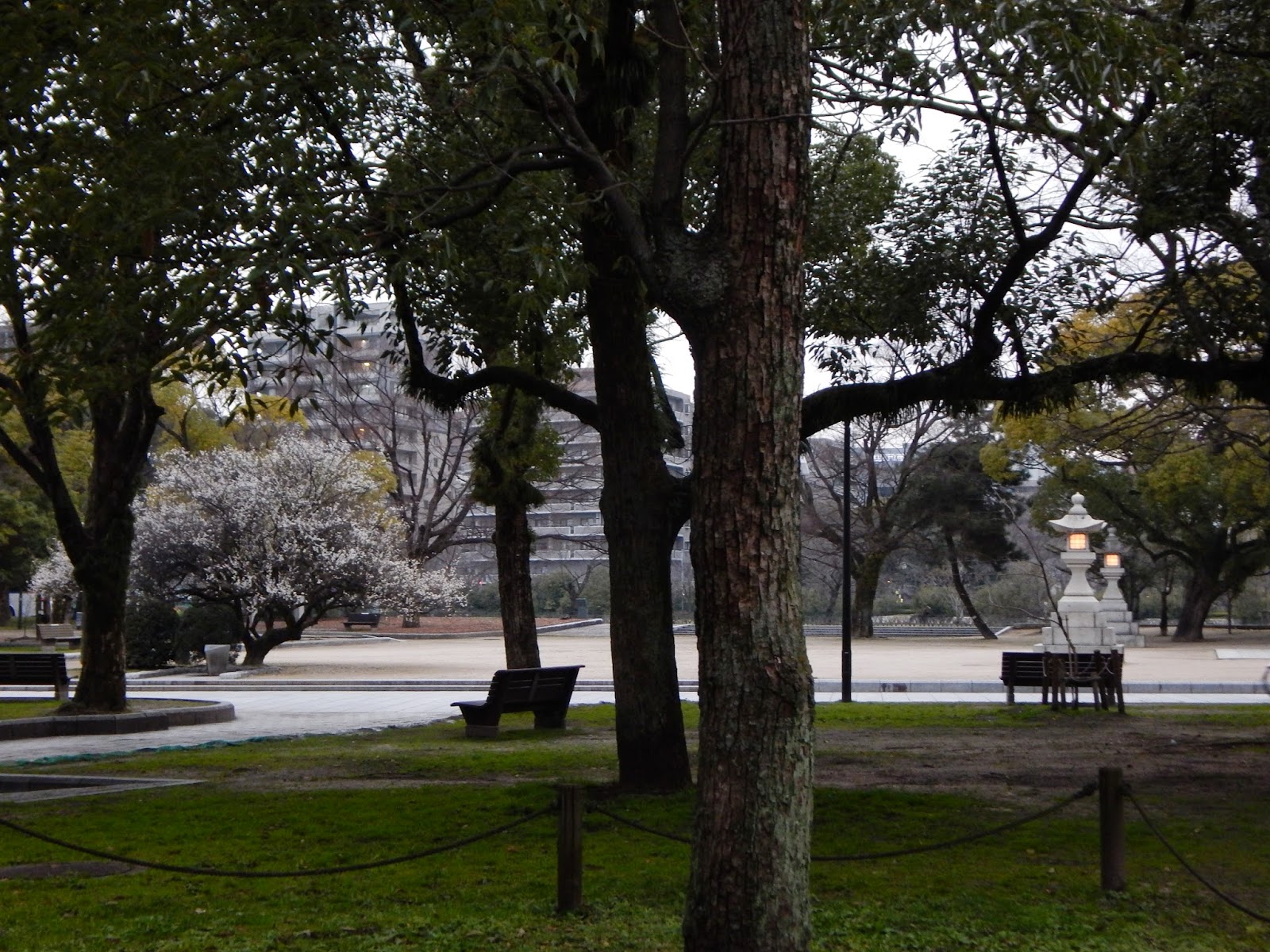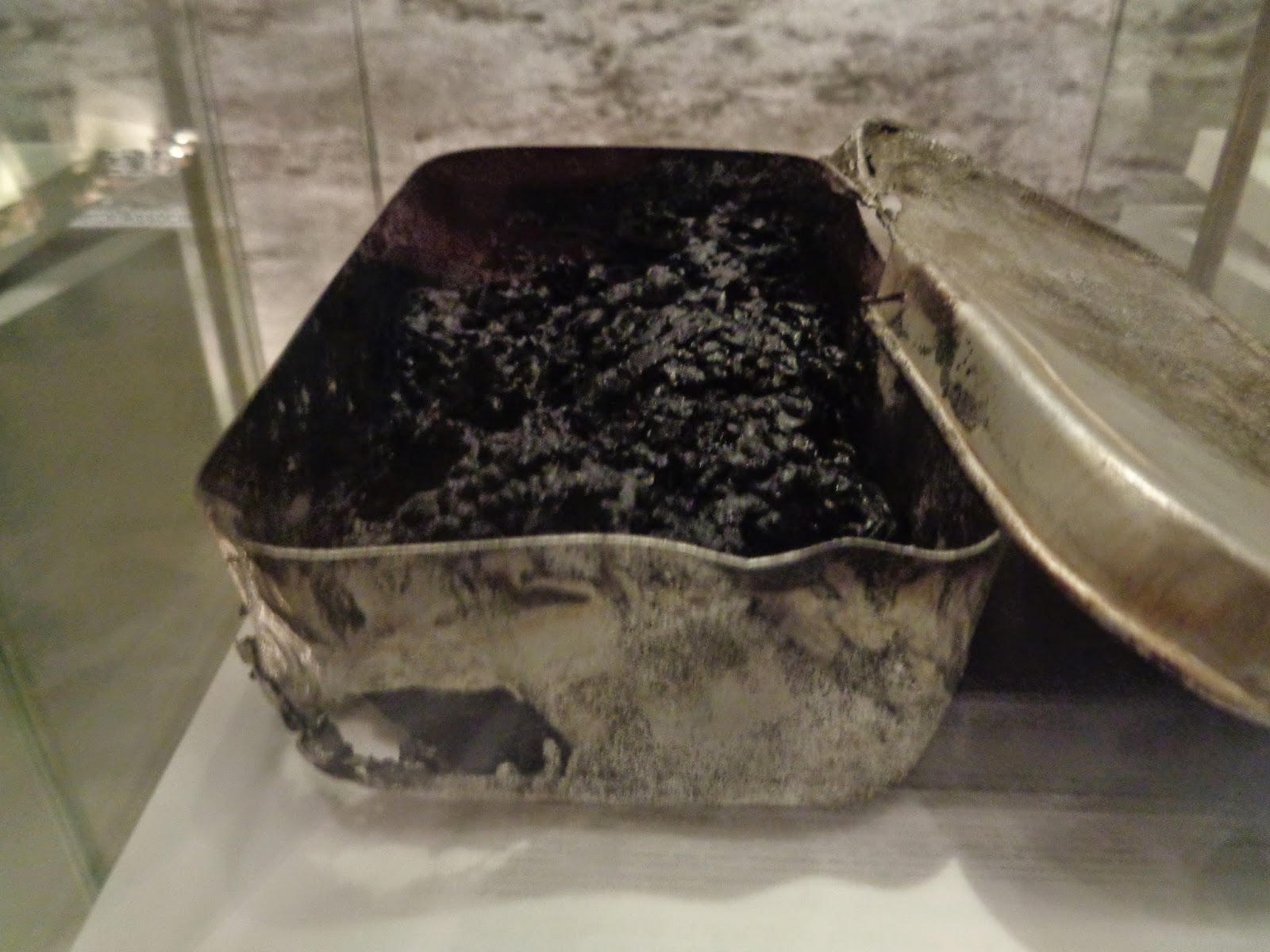After we crossed the street from the Peace Memorial Park, we got on the street trolley to head to Hiroshima Station.
We were trying to decide whether to go out to eat or just head over to the 7-11 where we were going to meet the pink Willer Bus that was going to take us back to Tokyo. We had about two hours to kill before our bus was due to arrive, so we had time to eat at a restaurant. But, we had only budgeted for eating out at Okonomimura and at the sukiyaki restaurant. We voted on it and decided that we had better play it safe and arrive at the 7-11 an hour early rather than eat out and rush to meet our bus.
The family on the street trolley as we head back to Hiroshima Station to get our luggage.
We had been in Hiroshima and Miyajima for two days. They were amazing days, full of emotional highs and lows. Miyajima was something out of a magical dream, and parts of Hiroshima were something out of a nightmare. Through these experiences, we had all grown immensely.
The children arrived in this city very scared of how people would treat them. While we were here, we all had many wonderful experiences that showed us over and over that the Japanese people have forgiven the atrocities of the atomic bomb that ravaged this city. The kids left this city feeling something very different: HOPE. The city of Hiroshima is a symbol to the world of hope, forgiveness, and peace.
I read somewhere as I was preparing for our trip that many tourists breeze through Hiroshima and don't really take the time to receive the gift that this city offers to its visitors. The gift of Hiroshima is hope. We didn't feel like we spent enough time here--certainly not at Miyajima--but because of the experiences that we had, we still left with our hearts full of the gift of Hiroshima. We will carry that gift of hope in our hearts forever.
We got our luggage out of the lockers at Hiroshima Station and walked around it for a bit looking for a store to buy diapers. We had two diapers left for Kirstina, and we still had a long night ahead. It took us a little while, but we found a store and bought diapers. Then, we made our way to our bus stop at 7-11. It was about 3 blocks from Hiroshima Station.
As we were walking there, I pulled out the itinerary to double check the time for the bus to arrive. I had it in my head that the bus was pulling out at 8:45 p.m., but when I double checked, the paper said that it was actually leaving at 7:45. I looked at the current time--it was 7:35 p.m.!! We had about two more blocks to go! We all ran as quickly as we could and arrived at the bus just as they were loading the luggage. Raymond got the luggage and kids loaded in the bus while I ran into the 7-11 and grabbed some quick dinner. We barely, barely made our bus!! Good thing we played it very safe and voted to arrive to the bus stop very early. If we had eaten at a restaurant like we had discussed, we would have missed our bus!
We spent the night sleeping on the bus as we made the long drive back to Tokyo. This bus ride was much more pleasant since the bus driver shut off the lights and didn't wake us up constantly. We all slept fairly well considering we were on a bus.
At 8:30 a.m. on Sunday, March 8th, we arrived back in Tokyo and said good-bye to our pink bus.
What a trip! We were tired, spent, and sick of traveling. So glad to be back in our own beds. But, wow, what amazing memories we made.
Our large family's experience in Japan for a semester....for better or for worse.
Tuesday, March 31, 2015
Peace Memorial Park
After we went through the museum, it was time to go through the Peace Memorial Park. It was designed to help one feel at peace with what happened. We would see how it made us all feel after we went through it. We were still a little upset by everything that we had been exposed to in the museum.
We found a bench and had a little snack and talked as a family about how we felt about the things in the museum and discussed America's need to drop the bomb to end the war once and for all.
Many people say that America should not have dropped the A-bomb because of the huge civilian lives that were lost, as well as how truly horrendous the devastation was afterward. But, these people do not know the Japanese people. The Japanese at the time were never, ever going to surrender--it was not a part of who they were. These same people do not know the history of the Battle of Okinawa. These people do not know about the Japanese invasions of their Asian neighbors. These people do not know that Japanese people did not see dying as a bad thing. It was noble to die for their country, and they would be celebrated afterward. These were the things we discussed with the kids as we had a snack. Was it awful? Of course. Do we wish it never happened? Of course! But, what other choice was there? An invasion of Japan similar to what happened at Okinawa would have cost many more lives on both sides of the war. It was a horrible tragedy, but the U.S. didn't see any other choice. The human race needs to learn from this tragedy and do everything they can to never let ourselves get in a similar situation. The Japanese way since this tragedy has been to advocate for peace. That's what this park is all about. Advocating for peace and creating peace within one's soul after going through the museum.

This statue is the image of a mother, who is trying to overcome difficulties, clinging to her child while covering another baby with her other hand. It's pretty haunting.

A fountain with a clock stuck on the time 8:15...which is the time that the bomb was dropped.
This monument stands in the center of the Peace Park. It resembles an ancient arch-shaped house, in part because of the desire to shelter the souls of the victims from the elements. Through the monument you can view the Peace Flame and the A-Bomb Dome. The monument is inscribed with the words, "Let all the souls here rest in peace, for we shall not repeat the evil." The stone chest in the center holds the names of people who died from the bombing, regardless of nationality.
This flame of hope for world peace has never burned out since August 1st, 1964. The pedestal was designed to suggest two hands pressed together at the wrist and bent back so that the palms point up to the sky. It is a symbol of the message: "Let's keep burning the fire until nuclear weapon is eliminated from the entire earth".
The flame of hope with the museum in the background.
At the Children's Peace Monument. After Sadako Sasaki's death, a campaign began to raise funds to build a memorial for Sadako and all of the children who died from the effects of the atomic bomb.
A bronze girl who holds a gold crane is standing on the top of the domed statue, and located next to the domed statue there are the statues of boys and girls symbolizing bright future and hope.
The bell inside of the Children's Monument.
There are millions and millions of paper cranes that are sent to this monument every year. They house them in these clear booths.
If you are going to leave a crane, they want you to register beforehand. Caitlin took care of the registration for our cranes.
After we finished the book on Sadako, we made several paper cranes (and other types of origami) and selected our very best ones to bring with us on our trip and leave at the Children's Monument. Here are the kids with their paper cranes that they are going to leave here.
Nathan hung his on the chain of the bell in the center of the monument. Some Japanese ladies were snapping pictures of him with his paper crane.
Putting our now registered paper cranes in the bin with millions of others.

This building was a short distance from the Children's Monument. This structure was a concrete building unlike the usual buildings made from wood at the time of the blast. The building was situated only 170 meters from the hypocenter and when the bomb exploded over this building the roof was crushed, the interior destroyed, and everything consumable burned except in the basement. Despite its proximity, it retained its basic shape because it was solidly built with few openings toward the hypocenter side. Thirty-seven people were working there at the time. All died except for one man who had gone down to the basement to get documents. He was the person who was the closest to the blast and lived through it. He died in June 1982. The building is now a souvenir shop and we went inside for a few minutes to warm up.
A picture of the A-bomb Dome building as it was before the bomb and the building itself across the river.
The Peace Bell is hung inside a dome-shape roof representing the universe. The Bell is symbolic of creating a world of peace and harmony, free of nuclear weapons.
The Atomic Bomb Memorial Mound, where it is estimated that the remains of 70,000 people are cremated in a vault inside the mound. Because this spot was close to the hypocenter, numerous corpses were collected here during the aftermath and then cremated.
The view of the river while we were standing on the Aioi Bridge.
This bridge was built in 1932 and was the target for the atom bomb. Surprisingly, it survived the explosion and was usable for 35 more years.
The entire view of the bridge.
Finally, we came to the A-Bomb Dome Building, which is the building closest to the hypocenter of the nuclear bomb. It has been left as it was found after the bombing in memory of the casualties. There was scaffolding around it because there were tests being conducted on it. It is such a precious historical landmark that needs to be preserved, hence tests are conducted every three years to make sure that it will continue to stand through future generations. Even through the scaffolding, we could see the burn marks on the concrete and brick walls.
A small shrine next to the A-Bomb Dome.
The sun had set, it was time to go. As we prepared to leave the park, we all affirmed that we did feel better after spending some time here. Somehow, peace was able to come into our hearts as we walked around.
Hiroshima Peace Memorial Museum Take 2
We so very much enjoyed being at Miyajima, it was hard to leave knowing what was in store for us at the Hiroshima Peace Memorial Museum. The kids DID NOT want to go back, but we told them that we had to. We often tell the kids that learning the history of the world is so very important because if we as members of the human race don't learn our history, we will repeat it. And, if we only learn about the easy and nice things in history, we won't be able to learn from the mistakes of others in the past. Because of this, we HAD to go back to the museum. We needed to learn about the atomic bomb drop in Hiroshima, even if it was going to be hard.
We took the metro back to Hiroshima Station and put our luggage in lockers and then went back to the memorial museum. This time, we politely declined the offer of the elevator way over on the other side of the museum and instead picked up and carried Kirstin in her stroller up the stairs just like we usually do.
The museum is very well organized and as you go through it, you see the events as they happened in chronological order. In the first room, they had this display of the city and where the bomb hit. The few buildings in the display are those that were still standing after the bomb dropped.
After we returned to Tokyo, we watched an interview on the internet of one of the men who was on the Hiroshima bomb mission. He said that they planned to drop the bomb where the two rivers met, which can been seen in the display. There is a bridge there in the shape of a T, which was easily visible from the air. The bomb exploded just to the side of the bridge. It is interesting to note that the main cluster of buildings that were able to survive the blast are directly under the bomb when it exploded.
A model of the atomic bomb known as Little Boy. This bomb was dropped on Hiroshima on August 6, 1945.
Against the walls on both sides of the central display, there were several belongings of people who were in the blast.....
Fifteen days after the bombing, the mother of Hiroko (then 18) started to comb her daughter's hair, but in three strokes it all came out except for a fringe along her hairline.Miyoko (then 13) was a first-year student in high school. She was exposed to the bomb at her building demolition work site. Her body was never found, but her mother found this wooden sandal two months laer. She recognized it by the straps that she had made herself using material from her kimono. The print of Miyoko's left foot remains on the sandal.
Shigeru Orimen was a first-year student in junior high school. He was exposed to the bomb at his building demolition work site. Early in the morning of August 9, his mother found a body with this lunch box clutched under the stomach. The lunch Shigeru never ate was charred black.
Shinichi Tetsutani (then 3 years and 11 months) loved to ride this tricycle. That morning, he was riding in front of his house when, in a sudden flash, he and his tricycle were badly burned. He died that night. His father felt he was too young to be buried in a lonely grave away from home, and thinking he could still play with the tricycle, he buried Shinichi with the tricycle in the backyard. In the summer of 1985, forty years later, his father dug up Shinichi's remains and transferred them to the family grave. This tricycle, after sleeping for 40 years in the backyard with Shinichi, was donated to the Peace Memorial Museum.
Toshiaki Asahi was a first-year student in junior high school. He was exposed to the bomb at his building demolition work site along with 325 other students and teachers. Nearly all died instantly. He made it to the river, where he stayed for a while. Later, he was found by a neighbor and taken to his home in Kabe-cho. Despite his serious injuries, he talked about the bombing, the damage, and what had happened to his friends. He even expressed concern about following the procedure for school absences. He died in the morning of August 9.There were other things, including skin. On some people, their skin seemed to 'melt' off of them. One mother saved the melted skin of her son who died a few days after the blast to show her husband who was off at war. That was just too gruesome and it didn't seem right to take a picture of that.
The kids learned that many of the children their age were not in school when the bomb was dropped. Instead, they were at their work sites. The government had decreed that these children leave school and instead spend their days working to aid in the war effort. This was something that my kids were not aware of.
Next room.....
A person sitting on the bank steps waiting for it to open was exposed to the flash from the atomic bomb explosion. Receiving the rays directly from the front, the victim undoubtedly died on the spot from massive burns. The surface of the surrounding stone steps was turned whitish by the intense heat rays. The place where the person was sitting remained dark like a shadow.
See where it is a little darker on the steps? That's the shadow.....More clothing, bags and bus tickets, and pictures of those who were burned.
Heads of Buddha statues at temples that were in the blast.
Roof tiles that were in the blast. They had some that we could touch. Several of them were melted and deformed.This brick wall was between the two buildings of the Hiroshima Army Clothing Depot. The ground there was weak and soft, so the violent shaking of the ground at a cracked part of the wall lifted the upper layers like a mountain.
Pictures of the devastation of the city and artifacts that we could touch.
Glass bottles that were melted together.
Tea cups that were melted together.
A collection of things that were found among the wreckage as they began to clean up the city.
Some were melted, others were so deformed that we didn't even know what they were until we looked them up on the list of items in the corner of the display.
A Buddhist statue from a temple.
Twenty-thirty minutes after the explosion, the dust and soot blown into the sky over Hiroshima began falling as rain over the northwest sections of the city. This rain fell as far as 29 kilometers from the hypocenter. This white plaster wall was part of a house about 3,700 meters from the hypocenter. The black stains are still clearly visible. Trace levels of radioactive substances from the A-bomb have been detected in those stains. Fish died and floated to the surface in the ponds and rivers where this rain fell. Many people who drank from the wells in the area where the black rain fell suffered from diarrhea for three months.Next room.....
The third room was full of pictures and short videos of people who suffered from the atomic bomb blast--some dead and some who probably wished they were dead. The pictures were upsetting and gruesome, and it didn't seem right to take photographs of such horrible human suffering. One picture I will always remember was of the back of a woman. She had a grid pattern burned into her back from the kimono she was wearing. The heat from the bomb blast penetrated more at the dark parts of the clothing that made up her kimono and actually went through and burned her skin in the cloth's pattern.
This room concluded with a large display about Sadako Sasaki and her life before and after the atomic bomb. When we first arrived in Japan, I read to the kids the chapter book titled Sadako and the Thousand Paper Cranes in preparation for this trip. We were all very interested in seeing this display.....

This is Sadako, before she got sick.
While Sadako was in the hospital suffering from leukemia, her family bought her a beautiful and very expensive silk kimono. They knew that she probably would not live much longer and so they spoiled her and not only got her a really nice kimono, but these shoes and purse to match.
Some of Sadako's kokeshi dolls that she played with and letters from classmates.
Some of Sadako's paper cranes...
They had several of Sadako's cranes, some so small that she had to fold them with pins. Seeing Sadako's personal belongings and her medical records really brought it all home to the kids and made it seem more real than it had before. We had all come to relate to Sadako through the book I had read to the kids, and it was a tender experience to see some of her personal belongings.
The last room was of the emergency response teams and how they helped after the bomb explosion. Finally, we saw pictures of many political figures from several countries in the world and how they were pledging to do everything they could to stop future atomic bomb blasts from occurring.
The museum was upsetting, as it should be.....it's designed to shock the person going through it. It was hard to read and see everything that we did in this building, but WOW!, how blessed we were to be able to be here and to see and learn all that we did! It was hard, but the kids did well. I think that going through it just a little bit the day before was a good thing, it helped them to know what was in store and allowed them time to mentally and emotionally prepare to go completely through it today and be able to learn rather than just cry through it all.
The museum was unbiased and unpolitical, which was refreshing. It provided the facts of what happened and didn't sugarcoat it or try to point fingers.
It was quite the experience, one that I hope none of us ever forget. Given the emotions that we all had as we walked through, I don't think we ever will.
Subscribe to:
Posts (Atom)

























































